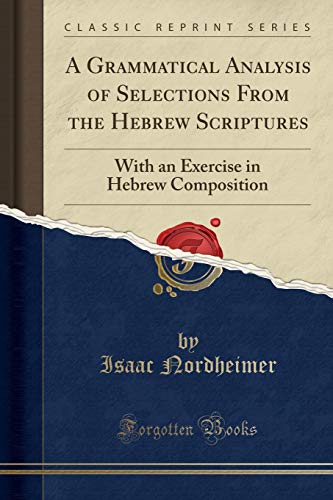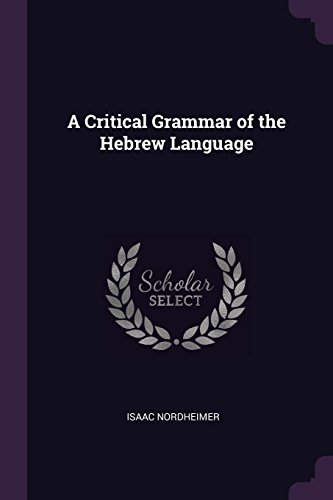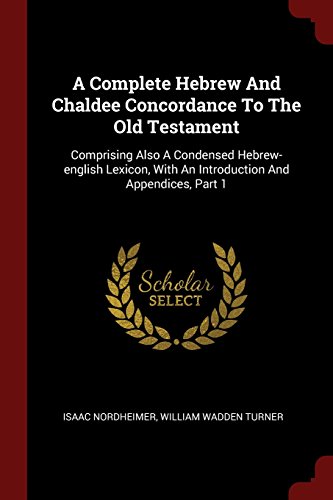Background
Isaac Nordheimer was born in 1809 in Memelsdorf, Bavaria, Germany to Meyer and Esther Natal (Strauss) Nordheimer.


(Excerpt from A Grammatical Analysis of Selections From th...)
Excerpt from A Grammatical Analysis of Selections From the Hebrew Scriptures: With an Exercise in Hebrew Composition III. The method of studying it in connection with the Gram mar. I. The intention of a chrestomathy or grammatical analysis is, that it may serve as a gradual introduction of the learner to the grammatical forms of a new language, by giving him, together with a knowledge of facts of which he was before entirely igno rant, a practical familiarity with those with which he has become theoretically acquainted by means of the grammar. For as every language has, in addition to a vocabulary proper to itself, a multi tude of peculiarities in the modes of expressing the relations of words and sentences to each other, it is absolutely requisite that he should become familiar with these, in order to make himself master of the ideas which a language contains, or to express his own thoughts in it with propriety. Although the Hebrew is remarkable for the regularity of its forms and inflections, and the simplicity of its construction; yet, being usually the first Oriental language which engages the atten tion of the Occidental student, the new facts which it discloses to his mind are exceedingly numerous and striking. The means for surmounting the consequent difficulties consist of the lexicon. About the Publisher Forgotten Books publishes hundreds of thousands of rare and classic books. Find more at www.forgottenbooks.com This book is a reproduction of an important historical work. Forgotten Books uses state-of-the-art technology to digitally reconstruct the work, preserving the original format whilst repairing imperfections present in the aged copy. In rare cases, an imperfection in the original, such as a blemish or missing page, may be replicated in our edition. We do, however, repair the vast majority of imperfections successfully; any imperfections that remain are intentionally left to preserve the state of such historical works.
https://www.amazon.com/Grammatical-Analysis-Selections-Hebrew-Scriptures/dp/1333901488?SubscriptionId=AKIAJRRWTH346WSPOAFQ&tag=prabook-20&linkCode=sp1&camp=2025&creative=165953&creativeASIN=1333901488

( This work has been selected by scholars as being cultur...)
This work has been selected by scholars as being culturally important, and is part of the knowledge base of civilization as we know it. This work was reproduced from the original artifact, and remains as true to the original work as possible. Therefore, you will see the original copyright references, library stamps (as most of these works have been housed in our most important libraries around the world), and other notations in the work. This work is in the public domain in the United States of America, and possibly other nations. Within the United States, you may freely copy and distribute this work, as no entity (individual or corporate) has a copyright on the body of the work. As a reproduction of a historical artifact, this work may contain missing or blurred pages, poor pictures, errant marks, etc. Scholars believe, and we concur, that this work is important enough to be preserved, reproduced, and made generally available to the public. We appreciate your support of the preservation process, and thank you for being an important part of keeping this knowledge alive and relevant.
https://www.amazon.com/Critical-Grammar-Hebrew-Language/dp/1377813355?SubscriptionId=AKIAJRRWTH346WSPOAFQ&tag=prabook-20&linkCode=sp1&camp=2025&creative=165953&creativeASIN=1377813355

( This work has been selected by scholars as being cultur...)
This work has been selected by scholars as being culturally important, and is part of the knowledge base of civilization as we know it. This work was reproduced from the original artifact, and remains as true to the original work as possible. Therefore, you will see the original copyright references, library stamps (as most of these works have been housed in our most important libraries around the world), and other notations in the work. This work is in the public domain in the United States of America, and possibly other nations. Within the United States, you may freely copy and distribute this work, as no entity (individual or corporate) has a copyright on the body of the work. As a reproduction of a historical artifact, this work may contain missing or blurred pages, poor pictures, errant marks, etc. Scholars believe, and we concur, that this work is important enough to be preserved, reproduced, and made generally available to the public. We appreciate your support of the preservation process, and thank you for being an important part of keeping this knowledge alive and relevant.
https://www.amazon.com/Complete-Hebrew-Chaldee-Concordance-Testament/dp/1376166089?SubscriptionId=AKIAJRRWTH346WSPOAFQ&tag=prabook-20&linkCode=sp1&camp=2025&creative=165953&creativeASIN=1376166089
Isaac Nordheimer was born in 1809 in Memelsdorf, Bavaria, Germany to Meyer and Esther Natal (Strauss) Nordheimer.
Nordheimer spent six years in the Yeshiba (Rabbinical Academy) at Presburg under the renowned Talmudist Moses Sofer gave him a thorough grounding in Hebrew and Aramaic literature. Thereafter, at the Gymnasium in Würzburg and at the Universities of Würzburg and Munich he gained his classical education and his knowledge of cognate Semitic languages, receiving the degree of Doctor of Philosophy at Munich in 1834.
In response to the urging of some American friends there, Nordheimer left Germany for the Western world, landing in New York in 1835. His mastery of Hebrew obtained for him in 1838, Jew though he was and remained, the position of instructor in sacred literature at Union Theological Seminary, where all the other members of the faculty had to profess the Westminster Confession. Attempts were made to draw him into religious controversy, but when his interpretations were challenged, he studiously limited himself to grammatical issues and was able to avoid all theological questions. From 1839 to 1840 he was also acting professor of Hebrew in the faculty of science and letters of the University of the City of New York, and from 1840 till his death, professor of German and of Oriental languages.
The eminent Semitic scholar Edward Robinson, in his report to the board of directors of Union Theological Seminary on June 28, 1842, testified to the great ability and fidelity with which Nordheimer instructed his classes, and to the very important aid which his labors gave to the reputation and best interests of the Seminary. By that time, however, Nordheimer, whose frame had always been frail, was exhausted by overwork, and four months later, at the early age of thirty-three, he died of tuberculosis.
His death destroyed the promise of the most brilliant Semitic grammarian of nineteenth-century America. On his voyage to America he had conceived the idea of writing a textbook of Hebrew grammar according to the laws governing philology and the development of speech. He offered the completed manuscript of his first volume to the printer B. L. Hamlen in New Haven. Hamlen, pointing to shelves filled with copies of Hebrew grammars by Gesenius, Stuart, and Bush, for which there was virtually no demand, would not even look at it. To Nordheimer's plea that the original discoveries on every page of his volume would make it live, Hamlen replied coldly, "Your book also will die. " Whereupon Nordheimer, pale with emotion, threw his manuscript on the counter, and said, "Den I will die wid my book. " Touched by the depth of feeling of the gentle, curly-headed scholar, Hamlen relented, accepted the manuscript for examination, and on a favorable report, printed the book. This was A Critical Grammar of the Hebrew Language in two volumes (1838 - 41) on which Nordheimer's reputation is based. It is an original and penetrating piece of clear and profound scholarship, which attempts to show lexical and grammatical relations with Indo-European as well as with Semitic forms. Nordheimer's other writings were A Grammatical Analysis of Selections from the Hebrew Scriptures (1838); an elaborate review of Fürst's Hebrew concordance to the Bible, in the Biblical Repertory and Princeton Review, July 1839; "Hebrew Lexicography"; "The Talmud and the Rabbies"; and "The Rabbies and Their Literature". He issued a prospectus of a Complete Hebrew and Chaldee Concordance to the Old Testament in the year of his death.
( This work has been selected by scholars as being cultur...)
( This work has been selected by scholars as being cultur...)
(Excerpt from A Grammatical Analysis of Selections From th...)
Nordheimer won the esteem of students and colleagues both for his simple-hearted, childlike, affectionate nature, and for his devotion, enthusiasm, and skill as a teacher.
Nordheimer never married.
